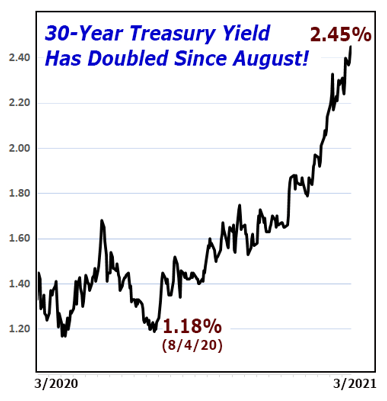Inflation Getting Ready to Explode — What to Do?
Martin here with an early warning:
 |
The yield on 30-year U.S. Treasury bonds has just doubled in the last eight months.
It was 1.18% on Aug. 4 of last year; now, it’s 2.45%.
A trivial event?
Far from it!
In fact, it could be the single most important turning point in the history of this decade.
Five-Alarm Inflation Warning
Fed watchers agonize over precisely why yields are surging.
Is Federal Reserve Chair Powell deliberately letting rates rise to help ward off future inflation?
Or are market forces driving rates higher despite his best efforts to hold them back?
But does it matter? Not really.
Either way, a new wave of inflation is on the way.
Indeed, the forces lined up behind an inflationary surge are the most powerful I’ve seen in my lifetime.
Inflationary force 1: Massive Fed money printing
Let me take you back 12 years.
On Sep. 10, 2008, the Fed had $926 billion on its balance sheet. In other words, in all the years since its creation in 1913, it had accumulated less than $1 trillion in assets from its money-printing operations.
Then, Lehman Brothers failed. Global markets came to the brink of Armageddon. The Great Financial Crisis erupted.
And the Fed responded with the wildest money printing binge of all time, adding $1.3 trillion to its balance sheet in 62 days.
In just two months’ time, the Fed printed more money than it had in all its 95 years prior.
But, if you think that’s extreme, consider this:
Before the COVID-19 crisis, the Fed’s balance sheet stood at $3.8 trillion. Now, it’s near $7.7 trillion. In other words:
The Fed has printed THREE times more money in this crisis than it did at the height of the Great Financial Crisis.
And people are still surprised that this might kindle the fires of inflation?
Inflationary force 2: Government spending gone wild
You might be wondering: if the Fed printed so much money back in 2008, why didn’t THAT drive inflation through the roof?
One reason is because the White House and Congress didn’t go wild with new spending.
Sure, they authorized about $700 billion to bail out the banks. But according to the Congressional Budget Office, they really dished out only $431 billion.
Besides, that wasn’t for spending. It was for loans, which were mostly paid back.
All told, including all government expenditures, the federal budget rose from $5.36 trillion in 2008 to $5.97 trillion in 2009, an increase of about $610 billion.
Compare that to what the White House and Congress are doing this time around.
You already know about the $2.7 trillion President Trump spent on the coronavirus crisis and economic stimulus.
You also know about the $1.9 trillion that President Biden added just in his first two months in office.
That adds up to $4.6 trillion and counting.
But have you contemplated the rest of Mr. Biden’s shopping list?
• Student loan forgiveness
• Climate change
• Infrastructure
• Expanded Obamacare
• Medicare for 60-year-olds
• Free college education
• Universal preschool
Total: Up to another $11 trillion.
Just with the $4.6 trillion that Congress has already authorized since the COVID-19 pandemic began, the government is adding more than seven times more to the budget than it did between 2008 to 2009.
Tack on new government expenditures of up to $11 trillion and it could be spending 25 times more than it did in the last crisis.
Big difference, right? But wait, there’s more.
Inflationary force 3: Reverse globalization
Another reason inflation didn’t take off in the 2010s was globalization.
China, India, Bangladesh and others poured a massive volume of cheap goods into global markets.
In effect, they exported deflation.
Today, the opposite is happening. China’s economy is recovering far sooner and faster than most other economies. Its wages are rising. Its middle-class spending power has grown dramatically.
If anything, China is starting to export INFLATION to the rest of the world.
That’s a dramatic reversal from the last decade.
What Happens When a Quack Theory
Becomes Conventional Wisdom
Right now, the so-called experts — on Wall Street and in Washington — are in denial.
In fact, this denial has a name. It’s called “Modern Monetary Theory.”
Sounds impressive, doesn’t it?
Like something cooked up in the ivory towers of academia by economists with PhDs who’ve written important scholarly papers…
…but who never learned how to tie their shoes.
What exactly does Modern Monetary Theory say?
It says government spending doesn’t have to be backed by anything at all.
Not by gold. Not by taxes. Not even by borrowing money with government bonds.
Governments can just keep spending and spending and spending. And nothing bad will ever happen!
Or so they think.
Unfortunately, though, Modern Monetary Theory is worse than a wild experiment by a mad scientist.
It has escaped from the lab of academia. And it has begun to spread around the world like a virus.
At first, most people thought it was a joke.
Anybody with an ounce of common sense knew that Modern Monetary Theory was absurd.
Unfortunately, common sense is a rare commodity among politicians and bureaucrats these days.
And before long, Modern Monetary Theory began to gain traction in the international economic community.
At the European Central Bank. The International Monetary Fund. Even in the halls of Congress.
Representatives like Alexandria Ocasio-Cortez said Modern Monetary Theory absolutely needs to be “a larger part of our conversation.” Others on the left are also jumping on board.
What about the folks in charge?
David Stockman, Budget Director under President Ronald Reagan, explains it this way: “We don’t often hear monetary authorities talking up the theory in public, but it is clearly the de facto policy most central banks are putting into practice.”
Indeed, Modern Monetary Theory has changed the ballgame when it comes to government spending.
Because according to Modern Monetary Theory, deficits don’t matter!
But history has taught us over and over again that deficits do matter.
For nearly 5,000 years of recorded history, we’ve seen evidence of societies getting into serious financial trouble (if not total collapse) because of too much debt.
Take ancient Rome, for example.
Many people think the Roman Empire fell because it was sacked by barbarians.
But the main reason the barbarians were able to succeed is because the Romans had already destroyed their own society from within, mostly thanks to Roman emperors spending money they didn’t have.
This, in turn, caused rampant inflation and devaluation of Roman money.
Under the early Roman emperor Caesar Augustus, a “denarius” coin was made of 99.5% real silver.
But 300 years later, during the reign of Claudius the Second, the amount of real silver in a denarius was down to just 0.02%.
By the end of the Roman Empire, many former Roman senators and other wealthy Roman citizens were reduced to moving to the countryside where they could eke out a living as subsistence farmers.
What happened to the emperors? Many of them were killed by starving mobs of angry Roman citizens.
In fact, only one of the last 30 Roman emperors died of natural causes!
Let’s Hope Our Leaders Learn
These Lessons Before It’s Too Late
But just in case they don’t, it’s high time you prepare.
That can include buying the best stocks in the market, especially those meriting the highest Weiss ratings.
Just bear in mind that much of the stock market rise in recent years has been driven by another big precursor to inflation: financial asset inflation.
In fact, if you measure the Dow against an objective standard — the price of gold, for example — you’ll see that stocks have actually been falling since the year 1999.
Back in August of 1999, the Dow Jones Industrial Average was worth 45 ounces of gold. Now, it’s worth only 19 ounces of gold.
So, measured in gold, the stock market has fallen 58% since 1999.
Or consider the Dow compared to Bitcoin (often called “digital gold”), and you’ll see that the financial asset inflation in the last few years has been even worse.
On Jan. 1, 2017, the Dow Jones Industrial Average traded for 20 Bitcoin. Today, it’s worth only about HALF of a Bitcoin.
Measured in Bitcoin, the stock market has fallen 97% — since 2017.
The bottom line should be obvious. Don’t invest exclusively in stocks. Also, look at gold, Bitcoin and other cryptocurrencies meriting our highest ratings that are true inflation hedges.
Good luck and God bless!
Martin

